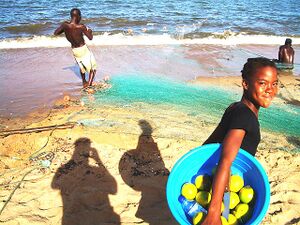
Mozambique, officially the Republic of Mozambique, is a country located in southeast Africa bordered by the Indian Ocean to the east, Tanzania to the north, Malawi and Zambia to the northwest, Zimbabwe to the west, and Eswatini and South Africa to the southwest. The sovereign state is separated from the Comoros, Mayotte and Madagascar by the Mozambique Channel to the east. The capital and largest city is Maputo.
Between the 7th and 11th centuries, a series of Swahili port towns developed on that area, which contributed to the development of a distinct Swahili culture and dialect. In the late medieval period, these towns were frequented by traders from Somalia, Ethiopia, Egypt, Arabia, Persia, and India. The voyage of Vasco da Gama in 1498 marked the arrival of the Portuguese, who began a gradual process of colonisation and settlement in 1505. After over four centuries of Portuguese rule, Mozambique gained independence in 1975, becoming the People's Republic of Mozambique shortly thereafter. After only two years of independence, the country descended into an intense and protracted civil war lasting from 1977 to 1992. In 1994, Mozambique held its first multiparty elections and has since remained a relatively stable presidential republic, although it still faces a low-intensity insurgency distinctively in the farthermost regions from the southern capital and where Islam is dominant.
Open spaces[edit | edit source]
The wildlife of Mozambique consists of the flora and fauna of this country in southeastern Africa.Mozambique has a range of different habitat types and an ecologically rich and diverse wildlife. This includes 236 species of mammal, 740 species of bird and 5,692 species of vascular plant. The Maputaland-Pondoland-Albany hotspot, with significantly high levels of biodiversity, stretches from the southern tip of Mozambique into northeastern South Africa.
Gorongosa National Park[edit | edit source]
Gorongosa National Park is at the southern end of the Great African Rift Valley in the heart of central Mozambique, Southeast Africa. The more than 4,000 square kilometres (1,500 sq mi) park comprises the valley floor and parts of surrounding plateaus. Rivers originating on nearby Mount Gorongosa (1,863 m (6,112 ft)) water the plain.
Seasonal flooding and waterlogging of the valley, which is composed of a mosaic of soil types, creates a variety of distinct ecosystems. Grasslands are dotted with patches of acacia trees, savannah, dry forest on sands and seasonally rain-filled pans, and termite hill thickets. The plateaus contain miombo and montane forests and a spectacular rain forest at the base of a series of limestone gorges.
This combination of unique features at one time supported some of the densest wildlife populations in all of Africa, including charismatic carnivores, herbivores, and over 500 bird species. But large mammal numbers were reduced by as much as 95% and ecosystems were stressed during the Mozambican Civil War (1977-1992).
The Carr Foundation/Gorongosa Restoration Project, a U.S. non-profit organization, has teamed with the Government of Mozambique to protect and restore the ecosystem of Gorongosa National Park and to develop an ecotourism industry to benefit local communities.
Food activism[edit | edit source]
Food security in Mozambique[edit | edit source]
According to the 2009 Human Development Report of the United Nations Development Programme, about 55 percent of the population of Mozambique is living in poverty, nearly half is illiterate, 40 percent is undernourished, only 47 percent have access to safe water, and there is a standing life expectancy at birth of only 48 years. Mozambique ranked 165th out of 169 countries in the human development index. Much of this is a result of the food insecurity in the country.
With more than 80 percent of its population dependent on agriculture for livelihood, Mozambique's food security can be extremely volatile. 90% of the land is made up of farms of 10 hectares (25 acres) or less.
Mozambique is particularly vulnerable to natural disasters such as droughts and floods, with a total of 15 over the last 25 years. These events greatly damaged the rural sector and the country's overall economy. For example, the floods of 2000 affected some 2 million people, while the droughts of 1994 and 1996 affected 1.5 million people in the southern and central parts of the country.
The poor are particularly vulnerable to weather-induced risks simply by virtue of their poverty. Poor households have few assets to sell and their consumption is already low, so in times of scarcity they do not have much to buffer them from food insecurity. Most households have little income or real food security, and women-headed households have even less.
Mozambique has a relatively well-developed system of disaster preparedness plans at the district level. Donor-funded projects related to the National Early Warning System help the government cope with food insecurity. W
News and comment[edit | edit source]
2011
Mozambique: Uniting Small Farmers for a Better Tomorrow,[1] October 24
2010
Mozambique: Demise of a massive biofuels project,[2] January 6
2009
2009 SEED Award Winners,[3] May 12
"The clean energy initiative". This project aims to provide rural electrification using sustainable energy, generating local employment and promoting entrepreneurial skills, by offering capacity building in the manufacture, installation and maintenance of micro wind turbines. The partners of this project are local small businesses and an academic institution.
External links[edit | edit source]
Wikipedia: Mozambique